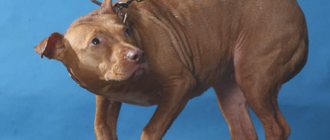An owner who carefully watches his four-legged pet can easily notice if the dog is trembling and lethargic. This can be caused by ordinary physiological reasons, such as cold or stress, or more serious ones associated with various diseases. In the first case, the symptoms disappear after eliminating their source, but the second case requires more careful monitoring of the pet, and in some cases even contacting a veterinarian.
Natural causes of the phenomenon
A dog may tremble for natural reasons. This often occurs when environmental conditions change or stress occurs. In this case, the dog can breathe frequently, but the general condition is not disturbed.
Cold or fear
Your pet may be shaking due to the cold. At low ambient temperatures, muscle contraction helps to warm up.
Another reason why a dog shakes with small tremors is fear. When scared, adrenaline and cortisol are released into the blood. Hormones help mobilize the body's defenses. This is manifested by rapid heartbeat, dilated pupils, and muscle tremors. This is why if a dog is scared, it shakes.
Sexual interest
Sexual desire also causes tremors. This occurs due to an increase in the level of sex hormones in the blood. Before mating, the pet trembles and has increased activity. A hormonal surge is not dangerous and does not require medical intervention.
Great excitement and delight
Strong emotions are also manifested by trembling. For example, if a pet begs for a treat or expects praise. In this case, trembling is not accompanied by other pathological signs. The dog breathes frequently, but behaves actively and excitedly.
Trembling you can ignore
Often trembling in animals occurs for natural, non-critical reasons.
Harmless factors that cause trembling include:
- cold;
- sexual rut;
- emotional sensitivity;
- fear;
- dream;
- age.
Freezing, the dog tucks its tail, begins to tremble, and breathes intermittently. An animal can freeze not only during a walk, but also at home, after water treatments.
Sexual activity promotes unusual behavior. Seeing individuals of the opposite sex, dogs begin to shake, whine, become overexcited, attract attention in every possible way, and try to run away. Only spayed or neutered males and females are not susceptible to this. Trembling caused by a hormonal surge during the period of attraction to a partner is safe for the pet; the condition is normalized when hormones naturally stabilize.
Dogs often shake from an excess of feelings - excitement, joy. The dog usually demonstrates this behavior when the owner returns or when visiting familiar guests. In older dogs, excess emotions can cause jaw trembling.
Trembling and rapid breathing are possible with fear; the dog may be afraid of a large animal, a crowded place, a sharp sound - a clap of thunder, a volley of fireworks, sirens of special equipment, etc.
Sometimes tremors appear during sleep, but the tremor disappears while awake.
Old dogs develop tremors in their limbs. Senile trembling of the hind and apron legs has little effect on the movement of dogs and does not require treatment in the absence of other disturbing symptoms.
Pathological causes
Trembling is not always a harmless condition. Sometimes this indicates pathology. If, in addition to tremor, other symptoms are observed, then most likely the tremors are pathological. It is important to monitor your pet’s consciousness and general condition.
Poisoning
In case of poisoning, trembling occurs as a response to intoxication. Other symptoms are also present:
- vomit:
- diarrhea;
- chills;
- sometimes increased body temperature.
The cause of poisoning can be food, medicines, household products, as well as toxic substances.
Electrolyte imbalance
Potassium and magnesium levels affect muscle contractions. Therefore, changes in electrolyte balance may be accompanied by tremor. Electrolyte disturbances often occur after childbirth. At the same time, the dog tucks its hind legs, lies and whines.
Hypothyroidism
Hypothyroidism is a condition characterized by insufficient production of thyroid hormones. The disease is manifested by a number of symptoms, one of which is tremor. In addition, the dog is lethargic and tired, and tends to sleep all the time. With hypothyroidism, the body temperature is reduced, the skin is dry, and the dog lies or hides most of the time.
Hypoglycemia
Low blood glucose levels can also manifest as muscle tremors. Hypoglycemia occurs under several conditions:
- when the dog was injected with too much insulin;
- in the presence of insulinoma - a benign tumor that produces insulin;
- with insufficient carbohydrate intake or excessive physical activity.
At the same time, the dog is trembling and breathing heavily, as if it was very frightened. In addition, your heart rate increases and your skin feels moist to the touch.
Heatstroke
If your pet is shaking after being in the sun for a long time, he may have heatstroke. Small breeds and puppies are especially susceptible to heat exchange disturbances. When heatstroke or sunstroke occurs, the dog is lethargic, panting heavily, and the skin is hot to the touch.
The dog is shaking
Dog owners sometimes have to see their dog shivering, especially if it's cold outside.
Trembling or tremors are rhythmic, rapid contractions of the muscle muscles of individual parts of the body (limbs) or the whole body, which the dog is unable to control.
Trembling in a dog can be due to both physiological and pathological reasons.
It is important to keep in mind that trembling in small breed dogs (Yorkies, Chihuahuas, Pomeranians, etc.) is mostly normal. These breeds of dogs express their fear by trembling, while they can simultaneously tuck their tail, ears and paws, squeal, and in some cases even involuntarily urinate (dog urinary incontinence).
Causes of trembling in dogs.
Trembling in a dog can be due to both physiological and pathological reasons.
Physiological reasons.
- During a walk in the winter, especially dogs of decorative breeds often shiver from the cold. Outwardly, such a dog shrinks, curls its tail and breathes intermittently. Due to the low temperature in the room, the dog may also shiver after bathing.
- Males almost always tremble when they see a bitch in heat. The male becomes extremely restless, begins to whine, breathe loudly, bark, and strives to break off the leash (estrus in dogs).
- Dogs often tremble from an excess of feelings, for example, after a long separation from their owner. Dogs of decorative breeds are most prone to such trembling.
- Some dogs tremble with fear - during a thunderstorm, fireworks, or the sound of emergency vehicle sirens.
Pathological reasons.
In the case when trembling in a dog kept in an apartment appears for no apparent reason and at the same time general symptoms appear - loss of appetite, increased body temperature, vomiting, diarrhea, etc. then this should be a signal to its owner that the animal is sick.
The most common diseases in dogs accompanied by trembling of the animal:
Infectious diseases.
Canine plague is a highly contagious viral disease of carnivorous animals characterized by fever, acute catarrhal inflammation of the mucous membranes of the eyes, respiratory tract, gastrointestinal tract disorder, and skin exanthema. In some cases, it is accompanied by damage to the central nervous system (meningitis, encephalitis).
In acute cases of plague, we note an increase in body temperature to 39.5-41 ° C, especially the temperature rises in the evenings or at night. The appetite is distorted, but most often it decreases, and at high temperatures it completely disappears (loss of appetite in the dog), tremors appear in the body. A sick animal's thirst increases. A comatose state develops, in which the dog or puppy dies on the 2-7th day of the disease (canine distemper).
Parvovirus enteritis is an acute, highly contagious viral disease of dogs caused by a pathogen of the parvovirus genus, accompanied by vomiting, hemorrhagic inflammation of the gastrointestinal tract, myocarditis, leukopenia, dehydration and death of puppies under 5 months of age (canine parvovirus enteritis).
Adenovirosis is a highly contagious disease of dogs caused by a DNA virus of the Adenoviridae family. The disease manifests itself primarily in the respiratory and, less commonly, digestive organs and conjunctiva.
The disease usually begins with a prolonged fever, body temperature rises by 0.5-1°C above normal, trembling, increasing coughing and sneezing, serous discharge from the nose and eyes, signs of pharyngitis, sore throat, laryngitis, bronchitis, conjunctivitis, and swelling of the lymph nodes. The submandibular and parotid lymph nodes are enlarged and inactive. The surface of the tonsils and velum is often reddened. Some dogs develop swelling in the neck area, accompanied by small hemorrhages; in puppies, adenovirus can be complicated by damage to the digestive tract and liver with characteristic clinical signs (loss of appetite, vomiting, diarrhea, pain on palpation) - canine adenovirus.
Infectious canine hepatitis is an acute contagious viral disease characterized by fever, catarrh of the mucous membrane of the respiratory and digestive tracts, damage to the liver and central nervous system.
In the acute course of the disease, which lasts from 2 to 10 days, the sick animal experiences depression, loss of appetite, thirst, vomiting mixed with bile, sometimes with blood, and diarrhea. Mucus and blood are found in the stool. The body temperature of a sick dog rises sharply to 40-41.5 ° C, we note shortness of breath and rapid breathing, trembling, disorder of the cardiovascular system, tachycardia, sometimes even with weakening of the pulse and arrhythmia, enlargement of the submandibular lymph nodes occurs, sore throat, rhinitis develops , conjunctivitis with profuse lacrimation, dogs develop weakness in the hind limbs, pain on palpation in the area of the xiphoid process, right costal arch (right hypochondrium) and abdomen, the border of the liver increases on palpation. Due to impaired synthesis of albumin in the liver, some sick animals may in some cases develop hypoproteinemic edema in the chest and abdominal cavity (infectious canine hepatitis).
Chlamydia. Canine chlamydia is an infectious disease caused by chlamydia abortus and psittacica and is accompanied by abortions, conjunctivitis, enteritis, pneumonia, arthritis, urethritis, orchitis, and encephalitis.
Considering that chlamydia is a zooanthroponosis, dogs with chlamydia are a potential source of infection for people, especially in large cities where dogs are kept in apartments.
For people, the consequences of contracting chlamydia can be very serious: abortion, infertility, chronic diseases of the genital area, arthritis, conjunctivitis, etc. Taking this into account, outreach work should be carried out with pet owners, recommendations should be given on preventive vaccinations of dogs against chlamydia, and even if a disease has arisen - compliance with the strictest personal hygiene measures, careful comprehensive treatment of the sick dog, conducting serological tests of the owners and all people in contact with the sick dog (canine chlamydia).
Leptospirosis is a zoonotic natural focal infectious disease of wild and domestic animals, including dogs and humans, characterized by fever, anemia, jaundice, hemoglobinuria, necrosis of the mucous membranes and skin, atony of the gastrointestinal tract, abortion and the birth of a non-viable litter.
The acute course of the disease most often occurs in young animals aged from one week to two years, and is characterized by fever (39.5-41.5 °C), which lasts from 2 to 8 days, tachycardia, the dog’s refusal to feed, trembling, depression and weakness. Breathing is frequent and shallow. By the end of the febrile period (4-6 days), the dog develops a sharp yellowness of the mucous membranes of the eyes, mouth, vagina, sclera and skin. The dog has difficulty urinating, the dog urinates in small portions, and the urine is cherry or brown in color. When taking blood samples for analysis and intravenously administering drugs, the blood quickly clots in the injection needle. Light tapping in the lumbar region causes pain, the dog arches its back, groans or growls. At the beginning of the disease, there is diarrhea, sometimes mixed with blood, which, due to atony of the gastrointestinal tract, turns into constipation. In bitches, milk production sharply decreases and then completely stops. The milk is saffron yellow (leptospirosis in dogs).
Parasitic diseases.
Worm infestation . No dog, regardless of breed or age, is immune from infection with helminthic diseases widespread in nature. Parasitic worms can enter a dog's body in a variety of ways.
Ways a dog can become infected with helminthic diseases:
The most common way of infecting a dog is through various external sources that contain helminth eggs - dog feces, food, water from puddles and ponds, licking dirty objects infected with eggs, raw fish, and so on. Dogs mainly become infected during daily walks. The second route of infection is more rare and occurs during direct contact of a dog with another dog sick with helminth infections or through intermediate hosts living on the dog - fleas and ticks.
Typical signs of worms in dogs are:
Disturbances in the functioning of the gastrointestinal tract - the dog develops a changeable appetite (periodic lack of appetite, or increased appetite), accompanied by a decrease in body weight. The dog's taste for food becomes distorted and begins to eat inedible objects. Periodic disorders of digestion and intestinal motility occur, which is manifested by frequent spasms, vomiting, diarrhea or constipation (constipation in dogs), bad breath appears (bad breath in dogs). Upon careful examination of the stool, we find mucus, blood, eggs, larvae in it or the parasites themselves. We register severe itching in the anal area. The dog strives to get rid of the itching through characteristic movements (“rides” on the back of the body). Upon external examination, the owners note that the dog has a swollen and hard abdomen against the background of protruding ribs. After eating, we notice hiccups in the dog; eating is difficult. On examination, the dog is lethargic, inactive, with symptoms of general anemia. The coat is dull and tousled, the dog has a tendency to develop dermatitis (dermatitis in dogs), eczema, dandruff, etc. The dog is characterized by retarded growth and development, the appearance of rickets (Hypovitaminosis D in dogs (rickets).
If your dog exhibits at least one of the above signs, you and your pet need to visit a veterinary clinic. Sometimes a dog may look completely healthy on the outside, but this does not mean that your dog does not have worms. In some cases, if a dog has a helminthic infestation, no symptoms occur for a long time. Therefore, in order to timely identify parasitic worms in your dog, you need to regularly take your dog for a preventive examination to a veterinary clinic (worms in dogs).
Piroplasmosis is a seasonal, naturally focal, parasitic blood disease, transmitted by tick bites, accompanied by weakness, trembling, high fever, red-brown urine, and jaundice. This is an insidious disease, the first warning symptom is often refusal of food, then depression appears (Piroplasmosis (babesiosis) in dogs).
Dirofilariasis is an invasive disease caused by nematodes of the genus Dirofylaria, which, after entering the body, migrate to the dog’s heart and during this journey the dog develops uncontrollable trembling.
Patients experience a dry cough, wheezing in the lungs, increased fatigue, shortness of breath, weight loss, heart failure, heart murmurs on auscultation, and rapid heartbeat. Edema may appear, especially in the intermaxillary space and lower extremities, and cyanosis of the skin and mucous membranes is noted. Kidney failure develops. As a result of the fact that heartworms can block arteries, the pressure in the blood vessels of the liver increases, which leads to hemolysis, anemia, hemoglobinuria, and bilirubinemia. Weakness of the pelvic limbs appears. The walls of the vessels in which microfilariae live are thickened, the lumens of the capillaries are narrowed, and hemorrhages are often found around the capillaries (dirofilariasis).
Toxoplasmosis is a natural focal anthropozoonotic disease caused in dogs by the protozoan intracellular parasite Toxoplasma gondii.
The symptoms of toxoplasmosis are quite pronounced and the disease in an infected dog is acute. The owners of their dog notice an increase in body temperature, the dog becomes indifferent, lies down, is not interested in anything, and the general condition is depressed. We note a complete lack of appetite and rapid weight loss. A disorder occurs in the activity of the gastrointestinal tract and manifests itself as constipation, which is replaced by diarrhea (diarrhea in dogs), vomiting (vomiting in dogs). During a clinical examination of a sick animal, veterinary specialists note purulent discharge from the nose and eyes. Breathing becomes shallow and heavy (the result of lung damage). A sick dog has damage to the nervous system, which is accompanied by symptoms of trembling, convulsions, paralysis, and paw paresis (toxoplasmosis in dogs).
Non-communicable diseases.
Trembling in dogs may be present in diseases of non-contagious etiology.
Epilepsy is a chronic disease characterized in animals by periodically recurring seizures of tonic-clonic convulsions with complete or partial loss of “consciousness.”
The disease most often occurs in German shepherds, boxers, dachshunds, and cocker spaniels.
Etiology. True, or congenital, epilepsy occurs in dogs as a result of defective intrauterine development of the fetus (with inbreeding, chronic diseases and intoxication of females during pregnancy).
The causes of symptomatic epilepsy are varied: the consequences of severe skull injuries, concussion and general concussion (traumatic epilepsy), complications after infectious diseases (canine distemper), hydrocephalus, etc.
Epileptic seizures in animals can occur due to vitamin deficiencies (B1, D), mineral deficiency (hypocalcemic or hypomagnesian), severe poisoning with salts of heavy metals and poisons.
Clinical picture. The onset of seizures in an animal is usually preceded by a few minutes by a short period of precursors - the dog develops causeless anxiety, increased fearfulness, sometimes circular movements, aimless wandering, excitement or depression, trembling, weakened response to external stimuli. At the time of the attack, the dog falls, seized by a tonic spasm of the entire body muscles. In this case, the dog’s limbs are tensely extended, the head is thrown back, breathing stops, and the eyes protrude from their sockets. Subsequently, muscle tension in the dog is replaced by clonic convulsions, first in the head area, and then they spread to the muscles of the trunk and limbs. The dog has noisy, intermittent breathing. With convulsive contractions of the jaws, saliva is whipped into foam, which, due to injuries to the tongue, is often stained with blood. During a seizure, the dog’s “consciousness” is lost, the pupils are dilated, do not react to light, sometimes the dog experiences involuntary release of urine and feces, the number of heart contractions and the number of respiratory movements sharply increase. After a seizure for 5-10 minutes, we note general weakness and depression in the dog, after which the animal returns to normal (epilepsy).
Hypoglycemia. With hypoglycemia, the dog develops trembling limbs, loss of strength and lethargy. Symptoms of hypoglycemia in a dog include severe drooling (drooling in dogs); in severe cases, the dog experiences convulsions, paralysis of the limbs and loss of consciousness.
Heatstroke . Heatstroke in dogs occurs on hot days outside or in a stuffy room or in a closed car. In addition to trembling, in a dog, heat stroke is accompanied by increased breathing, pulse, increased blood pressure, the mucous membranes of the mouth, nose and conjunctiva become red, and dry mucous membranes occur. The dog gets restless, moving from place to place, and its body temperature rises. If the dog is not helped in a timely manner, depression of the nervous system develops and shock occurs with loss of consciousness.
When the above symptoms appear, the dog is transferred to a cool room, the fur is moistened with water, and given plenty of water to drink.
To reduce body temperature, dogs are given enemas with cold water and analgin solution, and suppositories with analgin are administered rectally. You can make analgin with diphenhydramine intramuscularly, 3 ml of both for a large dog; 2 ml for an average dog; 1 ml per dog weighing 10 kg; 0.5 ml of diphenhydramine and analgin for dogs of dwarf breeds.
Hypothyroidism is manifested in a dog not only by trembling, but also by a decrease in body temperature and weakness.
Eclampsia . Occurs in dogs during pregnancy and lactation. There is a drop in the level of calcium in the blood, leading to disruption of the functioning of the nervous system, the appearance of tremors, which turns into convulsions. In some dogs, we note the appearance of vomiting, shortness of breath and increased body temperature.
Poisoning. Poisoning in dogs has been quite common in recent years. Basically, if a dog is poisoned, the owner of the dog is usually to blame. Most often a dog can get poisoned when:
During a walk, he has the opportunity to pick up low-quality food waste. Feeding poor quality, spoiled, sour food products. Failure to comply with food storage rules and regulations. Free access for the dog to household chemicals, fertilizers, and medicines. Including a large amount of meat products in your dog's diet.
Symptoms of poisoning in a dog. Depending on the type of toxic substance and the duration of its effect on the body, poisoning in a dog may be accompanied by the following symptoms:
Loss of appetite. A poisoned dog loses its appetite. The dog stops eating its usual food, refuses treats, skips several meals, while continuing to drink water.
Salivation. Drooling in a dog is usually a sign of nausea. And excessive drooling can be a sign of food poisoning, which is followed by the appearance of a lot of foam at the mouth (the dog is drooling).
Vomit. Vomiting is a complex reflex act caused by irritation of the vomiting center, in which the contents of the dog’s stomach are thrown out through the oral cavity. Vomiting is most often a protective reaction of the dog’s body from harmful and life-threatening substances (poisonous, toxic, inedible substances) that have entered the digestive tract. The vomit may contain blood if the dog is poisoned with rat poison, bile, etc. (vomiting in dogs).
Diarrhea. Diarrhea or diarrhea in dogs is mostly associated with damage to the gastrointestinal tract and is accompanied by liquid feces in the dog. With normal functioning of the digestive system, the dog goes to the toilet 2-4 times a day, usually after feeding, in the morning and in the evening. The most typical thing for the owner of a dog that suffers from diarrhea will be frequent loose stools, from which a putrid, rotten, pungent or other odor emanates. At the same time, a sick dog additionally experiences flatulence (the dog has a bubbling stomach), when examining the feces we find the presence of mucus or blood, the feces become liquid and frequent. If the color of the feces themselves turns black, then this may be a sign of internal bleeding in the stomach and intestines. When diarrhea occurs, the dog becomes lethargic, its appetite decreases, the animal becomes dehydrated, and weight loss occurs (dog diarrhea). Gastroenteritis. The main cause of gastroenteritis in dogs is nutritional factors (feeding spicy, rough, irritating, poor-quality food). Ingestion of heavy metal salts into the feed (poisoning with lead compounds, poisoning with zinc compounds), irritating drugs that damage the mucous membranes of the stomach and intestines (salicylates, glucocorticoids, anthelmintics, cytostatics, antibiotics, etc.). Often, while walking, dogs can find and eat food of unsuitable quality or completely spoiled, which can be a trigger for acute poisoning, damage to the intestinal and stomach mucosa, and, as a consequence, the development of gastroenteritis (gastroenteritis in dogs).
Lethargy. As a result of the action of toxins that have entered the body, the dog looks lethargic, does not want to go for a walk, and refuses to play. Muscle tremors. Decreased body temperature. Poisoning in animals is almost always accompanied by a decrease in body temperature.
Dermatitis is an inflammation of the superficial and deep layers of the skin. Young dogs under 5 years of age are most susceptible to the disease. Of the breeds that suffer most from dermatitis: pug, boxer, sharpei, chow chow, cocker spaniel, beagle, German shepherd, labrador, etc. Dermatitis occurs if poison enters the dog's body from the skin. For example, if a dog during a walk had contact with Sosnovsky's hogweed. At the site of contact with a poisonous plant, redness, blisters filled with liquid, rash, swelling, and itching appear.
Convulsions or tremors. In the event that a toxin that enters a dog’s body during poisoning begins to affect the central nervous system, the dog may: Shake. Lose consciousness. Involuntary urination. Involuntary bowel movements. Drooling appears. Lack of coordination - the dog cannot stand up, staggers, pulls its hind legs. Disruption of the central nervous system - the first sign is improper accommodation of the pupils, that is, they do not narrow to the light or do not dilate in moderate lighting.
Breathing is impaired. As a result of the action of toxic substances, fluid accumulates in the lungs and the functioning of the heart is disrupted. Outwardly, this manifests itself in the fact that the dog cannot take a deep breath, the nostrils are swollen when breathing, breathing becomes noisy and frequent (pulmonary edema in dogs).
There is a failure in the functioning of organs, primarily in which the neutralization and release of poisons and toxins that have entered the dog’s body occurs - hepatitis (liver disease in dogs), failure of the kidneys. Increased sensitivity to light. When poisoned by certain poisons, a dog becomes hypersensitive to light; the dog tends to hide in a dark corner of the room or in a kennel.
Loss of consciousness. The most unfavorable symptom of poisoning is when the dog loses consciousness and stops responding to its owner. It is urgent to call a veterinarian to take emergency measures. Obvious signs of intoxication in a dog during poisoning are observed on average after 7 hours; when a dog is poisoned with rat poison and other similar toxic substances, signs appear after 3 hours. With the development of gradual intoxication that slowly poisons the dog’s body, symptoms of poisoning may appear within a week or even a month.
First aid, treatment and prevention of poisoning in the article - poisoning in dogs: what to do?
First aid
First aid can be provided to your dog at home. If you notice that trembling is accompanied by other pathological symptoms, you need to act immediately.
If the dog is overheated, then it needs to be moved to a cool room. In other cases, it is enough to put the dog on its side and try to calm it down.
First aid for poisoning is to lavage the stomach and take enterosorbents. In case of hypoglycemia, you need to drink sweet water or glucose solution. However, this is only effective in cases where the owner knows the cause of the trembling.
What procedures does the veterinarian prescribe?
Appropriate treatment is prescribed by a veterinarian after the cause of the trembling is determined; sometimes it is necessary to undergo an examination and obtain test results.
In case of electrolyte imbalance, intravenous administration of a water-salt solution is required. To avoid further problems, you need to examine the thyroid gland, kidneys, and carry out proper treatment of the identified diseases.
In case of food poisoning, first aid can be provided to your pet at home; the dog is induced to vomit, given an absorbent, and provided with plenty of fluids. If the cause of intoxication is not clear, the dog should be shown to a veterinarian. Gastric lavage, intravenous drips, and the use of antispasmodics, antiemetics, homeopathic and cardiac medications may be required.
For animals suffering from epileptic seizures, the veterinarian prescribes antiepileptic drugs and anticonvulsants.
To eliminate allergy symptoms, antihistamines are prescribed; in some cases, antibiotics and the use of hormonal and antifungal drugs are required.
In case of hypothyroidism, the deficiency of hormones is compensated for with hormonal drugs, the dosage of which is calculated only by a doctor.
In case of hypoglycemia, glucose injections are given; advanced disease requires thorough treatment; failure to provide timely assistance threatens hypoglycemic coma and death of the animal.
Depending on the virus or infection, different drugs are prescribed; these can be antibiotics and vitamins, mucolytic cough suppressants, immunostimulants, antiviral injections and other medications. In the fight against worms, deworming tablets or suspensions are used.
Dogs are prescribed sedatives to eliminate anxiety caused by changes in residence, exhibitions and other situations.
Depending on the severity of the injury, different treatment methods are used; painkillers can be used for pain syndromes.
If calcium levels are insufficient in pregnant or pregnant dogs, calcium chloride injections or calcium gluconate supplements are prescribed.
For all diseases, only a veterinarian can provide proper treatment.
Parasitic diseases
Shivering in a dog can also be caused by parasitic organisms.
Among them:
- Helminthic infestation is infection by helminths. Accompanied by shaking during defecation.
- Dirofilariasis. When parasites enter an animal's body, they rush to the heart. The result is trembling, swelling, and a dry, frequent cough. The pet becomes apathetic.
- Piroplasmosis is blood poisoning from a tick bite. Symptoms of the disease: heavy breathing, shaking, brown urine, loss of balance.
Infection of a pet's body with parasites is also sometimes accompanied by the appearance of trembling.
What to do if your dog is breathing heavily
So, there are many reasons for breathing problems in dogs.
What to do if your dog is breathing heavily? First you need to analyze what the general condition of the animal is. To do this, you need not only to pay attention to the sound of breathing and count the frequency of inhalations and exhalations, but also measure the pulse (normally, this indicator ranges from 70 to 180 beats per minute, for small ones the figure is close to 180 beats, for large ones - to 70). It is important to know what your dog's temperature is. Normally, in a healthy animal, the temperature is 37.5-39 degrees. It would also be useful to measure blood pressure, which in an adult dog should be in the range from 110/60 to 145/95 mmHg.
You definitely need to pay attention to alarming symptoms in the form of stomach and intestinal disorders, changes in the normal shade of the mucous membranes, problems with coordination, loss of appetite, and so on. If your dog is clearly not feeling well, then it’s time to go to the vet.
, since diagnosis at home “by eye” is impossible. Almost always, heavy breathing is a sign of a serious illness, so it is better not to waste precious time.
Normal breathing
Signs of normal breathing in pets are a closed mouth and absence of sounds. Under optimal conditions, the animal takes 10-30 breaths per minute.
The value depends on the following factors:
- gender (males have a less frequent respiratory rhythm);
- breeds; size (the respiratory rate of small animals is 15-30, and of large animals – 10-20 times);
- age.
Puppies at two months of age, under normal circumstances, breathe at a rate of 60-100 times per minute.
Exceeding the norm indicates a deterioration in the dog’s health. You should watch how she breathes.
“Shaking” dogs: characteristics of small pets - Yorkies, toy terriers and others
Yorkshire Terrier Owners of Yorkshire Terriers are not surprised that their pets often tremble.
This is a normal reaction to cold. The body of these animals is so small that to warm it, it is necessary to accelerate the blood flow, and trembling helps to avoid hypothermia. In addition to the Yorkie, the "shaky" breed category also includes the Spitz, Italian Greyhound and Chihuahua. To prevent these animals from freezing, their owners should not take them out for a walk without warm clothing. Share with friends!
Hormonal and nutritional problems
The causes of tremors in pets may lie in hormonal imbalances in the animal’s body: during estrus in females and rutting in males, excitability increases. The problem resolves with the end of this period, and if desired, it can be eliminated by castration.
Often, animals whose diet has changed or are taking medications have an allergic reaction to new foods and medications, which can also cause trembling. This reaction is also caused by poisoning, which in addition to trembling is accompanied by nausea, vomiting, diarrhea, apathy, and lethargy.
Foods or medications that cause such phenomena should be excluded from the diet, and if necessary, antihistamines should be given and the animal should be shown to a veterinarian.
Heavy breathing in a pregnant dog
If a pregnant bitch, nearing her due date, suddenly begins to breathe rapidly, it means that the puppies are already asking to come out. In such cases, the animal begins to tremble finely, and breathing becomes shallow. Even if the owner is at a distance from the dog, he can clearly hear the sound of its breathing. In this situation, you should not be afraid, since rapid breathing is a purely physiological phenomenon.
When an animal experiences its first contractions before giving birth, these spasms can be very painful. By breathing frequently, the expectant mother instinctively tries to reduce pain. If a dog begins to breathe frequently before giving birth, the owner should:
- do not disturb the animal. Most likely, the bitch will soon give birth safely;
- prepare a “house” for newborn puppies;
- Give the animal to drink some water from a spoon. If the dog refuses, forcing it to drink is not recommended;
- Call the veterinarian if heavy breathing continues for a long time, but labor does not occur.
When a bitch gives birth to puppies, she begins to nurse them. During lactation, the body of an adult dog is especially vulnerable. With breast milk, the bitch provides her puppies with vitamins, minerals and other vital substances necessary for normal growth and development. Prolonged breastfeeding exhausts the body. The pet loses especially a lot of calcium and glucose. Their deficiency can lead to a dangerous condition, which in medicine is called “eclampsia”. Eclampsia is characterized by rapid breathing and convulsions. In this case, you must urgently call a veterinarian. If you miss precious time, the dog will collapse, the animal will lose consciousness and die.
Why the dog shakes: psychological reasons
The dog is shaking, experiencing:
- Severe stress, for example in anticipation of punishment.
- Fear caused by a loud sharp sound, the appearance of a large relative of a menacing appearance in the field of vision, etc.
- Intense anxiety, which can be associated with both positive and negative emotions. Some dogs tremble in their sleep when they dream of something pleasant, in anticipation of meeting their beloved owner or being treated to a treat.
A dog's shaking may be an attempt to get the owner's attention. This behavior can be compared to wagging a tail. Usually, when the above factors are eliminated, the pet stops shaking.
Prevention measures
In order for the dog to always breathe well, the owner must take care of the pet’s health. You should regularly take your animal to the veterinarian, get preventive vaccinations on time, and treat for worms, pests and parasites. On hot days, you can only walk your dog in the shade. If she always gets out of breath from running fast, she should avoid participating in agility and other competitions where reaction and speed are required.
For dogs with heart problems and pregnant bitches, it is advisable to organize a gentle regime at home. If the animal sleeps a lot during the day, this should not be prevented. You should never forcibly wake up your pet, even if the dog suddenly fell asleep, as it seemed to the owner, at the wrong time.
It is necessary to protect your pet from all infections and protect it from contact with street dogs. If she has chronic respiratory disorders, you should not arrange noisy games for the animal. Also, you should not take sick dogs hunting.
Useful tips
In order for the dog to always breathe well and have a healthy heart, the owner must pay great attention to the prevention of obesity. To do this, it is not necessary to put your pet on a strict diet. Sometimes it is enough to simply replace food from the owner’s table with special food and wean the animal from begging for tidbits. You should also completely exclude baked goods and sweets, sausages and other sausages from the animal’s diet.
To prevent obesity, you need to walk a lot with your animal. To avoid missing the onset of heart disease, older pets need regular electrocardiograms (for large breeds) or heart ultrasound (for small breeds). If the doctor has prescribed your pet some medications to improve cardiac activity, they must be taken as a course, and not occasionally.
Heavy breathing in a dog does not always indicate illness. On the contrary, most often this disorder is temporary, does not require treatment and goes away on its own. However, the owner must closely monitor the well-being of his pet and contact a veterinarian at the slightest deviation. Only in this case will the dog grow up healthy and live for many years. Breathing is a serious issue, so a dog owner should understand that if there is even the slightest suspicion of respiratory distress, they should immediately take their dog to a veterinarian.
When is a visit to the vet necessary?
A visit to a canine doctor is required for animals with the following clinical signs:
- with high or low temperature;
- dyspeptic disorders - vomiting or diarrhea;
- lacrimation, rhinitis or secretion of large volumes of saliva;
- refusal of food or water.
When visiting the clinic, your pet will undergo a full examination and diagnostic examination, which will help to understand the cause of the deviation. Identifying diseases at the primary stages of development gives a better chance of recovery. Ignoring obvious symptoms will lead to the pathology becoming chronic, and in worst cases, to the death of the animal.
It is impossible to accurately determine the source of muscle contractions in a pet without diagnostics - the doctor is based not only on visual examination data, but also on the results of laboratory tests. Many owners make the mistake of mistaking pathology for physiological manifestations, wasting precious minutes.
How to help your pet
Having figured out why the dog is trembling, you need to quickly help it. If there is nothing dangerous, help from the owner will suffice. But if you suspect a pathology, you need to consult a veterinarian.
How to eliminate harmless tremors
If you are sure that the tremor is associated with physiological factors, then you can cope with the situation yourself. A frozen dog should be warmed up - wrapped in a blanket and given warm broth to drink. If you have a breed with short hair, then do not forget to buy warm clothes for autumn and winter walks. You should not take your pet out into severe frosts for a long time - a few minutes are enough to relieve itself.
Make sure that the animal does not experience strong disturbances. An older dog's jaw may shake during or after eating - this is normal.
During the heat period, try to be outside with your dog as little as possible. Ask your veterinarian for advice - he may recommend herbal sedatives.
Treatment option for shaking and whining
The first thing to do is find the reason. If there are no physical pathologies, then most likely there is a psychological reason or manipulation.
What can be done:
- Observe. Perhaps with more careful observation you will immediately find the reason. If this happens, eliminate the irritating factor as quickly as possible.
- Pay more attention and be gentle with the dog. Perhaps the reason is precisely the emotional factor.
- Feed correctly. Very often, the cause of trembling and whining is incorrectly selected products. The dog just has gastrointestinal problems. If this is the case, try to switch your pet to a lighter diet. Eliminate fatty and heavy foods.
- Be sure to consult your veterinarian.











